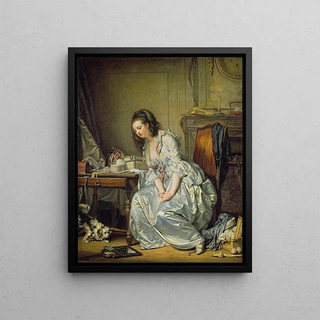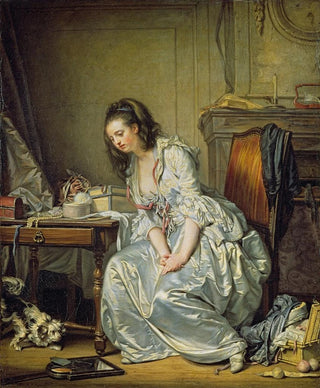Art print | The Broken Mirror - Jean-Baptiste Greuze


View from behind

Frame (optional)
Art print of The Broken Mirror - Jean-Baptiste Greuze – Captivating Introduction
In the vast panorama of art history, certain works stand out for their ability to capture the very essence of humanity. "The Broken Mirror" by Jean-Baptiste Greuze is a perfect example. This canvas, imbued with striking delicacy and emotional depth, transports us to a world where beauty and melancholy intertwine. Created at the end of the 18th century, the piece not only evokes the fragility of life but also the complexity of human emotions. Through this work, Greuze invites us to contemplate the nuances of the soul, to explore the feelings that animate us, while confronting us with the sometimes brutal reality of existence.
Style and uniqueness of the work
Greuze's style is characterized by poignant realism, meticulous attention to detail, and masterful use of light and shadow. In "The Broken Mirror," the play of reflections and shadows creates an atmosphere that is both intimate and unsettling. The composition, centered on a young woman with a face marked by sadness, is accentuated by the symbolic presence of the broken mirror, which suggests loss and disillusionment. The colors, soft and nuanced, reinforce the emotion emanating from the scene. Greuze, a true master of portraiture, manages to translate complex feelings through visual language, making each gaze, each gesture, loaded with meaning. This work does not merely depict a human figure; it tells a story, that of introspection, a quest for self in the face of life's trials.
The artist and his influence
Jean-Baptiste Greuze, an emblematic figure of the Rococo movement, established himself as an innovator in the fields of portraiture and genre painting. His unique approach, combining sensitivity and technique, influenced many artists of his time and future generations. Greuze was able to capture the spirit of the age, translating the aspirations and struggles of 18th-century French society. His interest in themes of morality and the human condition paved the way for deeper reflections on the role of art in the

Matte finish

View from behind

Frame (optional)
Art print of The Broken Mirror - Jean-Baptiste Greuze – Captivating Introduction
In the vast panorama of art history, certain works stand out for their ability to capture the very essence of humanity. "The Broken Mirror" by Jean-Baptiste Greuze is a perfect example. This canvas, imbued with striking delicacy and emotional depth, transports us to a world where beauty and melancholy intertwine. Created at the end of the 18th century, the piece not only evokes the fragility of life but also the complexity of human emotions. Through this work, Greuze invites us to contemplate the nuances of the soul, to explore the feelings that animate us, while confronting us with the sometimes brutal reality of existence.
Style and uniqueness of the work
Greuze's style is characterized by poignant realism, meticulous attention to detail, and masterful use of light and shadow. In "The Broken Mirror," the play of reflections and shadows creates an atmosphere that is both intimate and unsettling. The composition, centered on a young woman with a face marked by sadness, is accentuated by the symbolic presence of the broken mirror, which suggests loss and disillusionment. The colors, soft and nuanced, reinforce the emotion emanating from the scene. Greuze, a true master of portraiture, manages to translate complex feelings through visual language, making each gaze, each gesture, loaded with meaning. This work does not merely depict a human figure; it tells a story, that of introspection, a quest for self in the face of life's trials.
The artist and his influence
Jean-Baptiste Greuze, an emblematic figure of the Rococo movement, established himself as an innovator in the fields of portraiture and genre painting. His unique approach, combining sensitivity and technique, influenced many artists of his time and future generations. Greuze was able to capture the spirit of the age, translating the aspirations and struggles of 18th-century French society. His interest in themes of morality and the human condition paved the way for deeper reflections on the role of art in the






